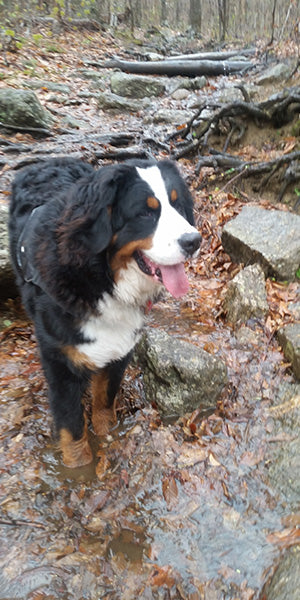Hiking with your dog can add a wonderful dimension to your time on the trail—but you need to plan before you go. Note: In most states, if your dog is injured, search and rescue will not assist you. Be prepared to rescue your pet or find assistance on your own.

 Article first appeared at: http://hikesafe.com/index.php?page=hiking-with-your-dog
Article first appeared at: http://hikesafe.com/index.php?page=hiking-with-your-dog
To hike with you, your dog should be healthy, fit and obedient.
- Make sure your dog is fit enough. Just as a couch potato human shouldn't set out on a challenging hike without training for it, neither should a semi-active or overweight dog. Remember, hiking is a lot more strenuous than walking. Short training hikes can be fun, too.
- Make sure the terrain you plan to hike is suitable for your dog. Every dog isn't suitable for every trail!
- Your dog should also reliably respond to voice commands.
- Your dog should have a collar with an ID tag that has your contact info - and you'll need a leash, too, as some places require them. Many hikers use a waist belt system for day hikes, or a leash that can clip to their pack. You may want to add a small bell to the collar; the sound can help you know where your dog is when off leash.

Discuss your plans for hiking with your dog with your vet.
If you plan to have your dog help carry the load, ask your vet if this is OK and how much your dog can carry. Typically young and healthy dogs can carry up to 25% of their body weight, although some breeds or individual dogs can carry 10%-15% more.Once you've picked a trail, check to see if dogs are allowed.
If so, if leashes are required or if dogs are only allowed in limited areas. Still, it's best to keep your dog on a leash, as there may be people who are frightened of dogs or who object to them being on the trail, or there may be other dogs on the trail who may be aggressive towards your dog. Stop often to check your dogs for cuts and ticks, and again at the end of your hike.Since dogs can't sweat, avoid hiking during the hottest part of the day.
Always carry a dog kit with:
- plastic bags (if you plan to carry out your dog's waste) or a trowel/spade (so you can bury feces well off the trail).
- basic first aid supplies.
- water and a collapsible bowl. (Don't let your dog drink from streams or puddles.)
- snacks or food.
- an extra collar and leash.
- a current picture of your dog in case it becomes lost (this could be on your phone).
- a fluorescent orange reflective vest if you are hiking during hunting season or after dark.
- dog booties (depending on the season and the terrain).
- your vet's contact info.
If your dog will be carrying a pack, be sure you fit it properly.
If you tighten the straps too much, the dog won't be able to breathe properly; if they're too loose, the pack could slip off or chafe. For more on hiking with your dog, see these articles from AMC Outdoors: Article first appeared at: http://hikesafe.com/index.php?page=hiking-with-your-dog
Article first appeared at: http://hikesafe.com/index.php?page=hiking-with-your-dog






















